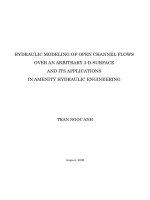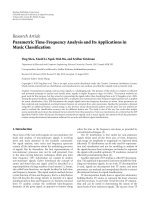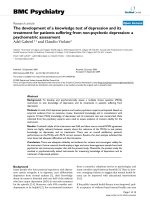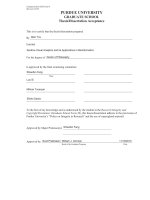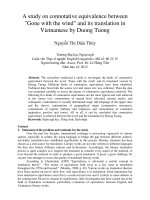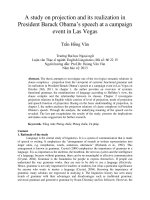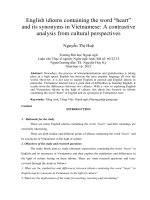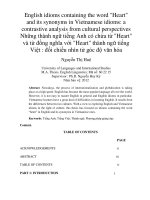A word image coding technique and its applications in information retrieval from imaged documents
Bạn đang xem bản rút gọn của tài liệu. Xem và tải ngay bản đầy đủ của tài liệu tại đây (1.7 MB, 98 trang )
A WORD IMAGE CODING TECHNIQUE AND ITS
APPLICATIONS IN INFORMATION RETRIEVAL FROM
IMAGED DOCUMENTS
ZHANG LI
(B.Sc. (Hons), NUS)
A THESIS SUBMITTED
FOR THE DEGREE OF MASTER OF SCIENCE
SCHOOL OF COMPUTING
NATIONAL UNIVERSITY OF SINGAPORE
2004
i
Acknowledgements
It is a great pleasure to render my sincere appreciation to all those people that have
generously offered their invaluable help and assistance in completing this research work.
First of all, I would like to thank Associate Professor Tan Chew Lim, for his ingenious
supervision and guidance during the whole year of my master study; and also for his
consistent encouragement and generous support in my research work.
I am also grateful to Dr. Lu Yue, who continuously provided his invaluable suggestions and
guidance to this project work. It is my great pleasure to work with him and share his insights
in document image retrieval area.
Last but not least, I would like to express my gratitude to Dr. Xiao Tao for sharing with me
his knowledge in Wavelet Transformation as well as his ingenious idea in Pattern Recognition
field.
ii
Table of Contents
Acknowledgements i
Table of Contents ii
Summary iv
List of Tables vi
List of Figures vii
Chapter 1 Introduction 1
1.1 Background 1
1.2 Scope and Contributions 5
1.3 Organization of the Thesis 9
Chapter 2 Feature Code File Generation 11
2.1 Connected Component Analysis 11
2.2 Word Bounding 13
2.3 Skew Estimation 14
2.4 Skew Rectification 18
2.5 Word Bounding Box Regeneration 20
2.6 Italic Font Detection 21
2.7 Italic Font Rectification 22
2.8 Feature Code File Generation 22
Chapter 3 Word Image Coding 24
3.1 LRPS Feature Representation 24
3.2 Ascender-and-descender Attribute 24
3.3 Line-or-traversal Attribute 25
3.3.1 Straight Stroke Line Feature 26
3.3.2 Traversal Feature 28
3.4 Post-processing 30
3.4.1 Merging Consecutive Identical Primitives 30
3.4.2 Refinement for Font Independence 31
3.5 Primitive String Token for Standard Characters 33
3.6 Verification 34
Chapter 4 Italic Font Recognition 36
4.1 Background of Font Recognition 36
4.2 Wavelet Transformation Based Approach 38
4.2.1 Wavelet Decomposition of Word Images 39
4.2.1.1 Pyramid Transform 39
4.2.1.2 Coupled and uncoupled Wavelet Decomposition 40
iii
4.2.2 Statistical Analysis of Stroke Patterns 43
4.2.2.1 Vertical Stroke Analysis 44
4.2.2.2 Diagonal Stroke Analysis 45
4.2.3 Experimental Results 46
Chapter 5 Feature Code Matching 48
5.1 Coarse Matching 48
5.2 Inexact String Matching 49
Chapter 6 Web-based Document Image Retrieval System 56
6.1 System Overview 56
6.2 System Implementation 58
6.3 AND/OR/NOT Operations 60
6.3.1 AND Operation 61
6.3.2 OR Operation 62
6.3.3 NOT Operation 64
6.4 System Evaluation 64
Chapter 7 Search Engine for Imaged Documents 69
7.1 Implementation 69
7.2 Performance Evaluation 71
7.3 Comparison with the Page Capture 73
7.4 Comparison with Hausdorff Distance Based Search Engine 74
7.4.1 Space Elimination and Scale Normalization 75
7.4.2 Word Matching Based on Hausdorff Distance 76
Chapter 8 Conclusions 79
8.1 Contributions 80
8.2 Future Works 81
Bibliography 83
Appendix A – How to Use the Web-based Retrieval System 87
Appendix B – How to Use the Search Engine 88
iv
Summary
With an increasing amount of documents being scanned and archived in the form of digital
images, Document Image Retrieval, as part of information retrieval paradigm, has been
attracting a continuous attention among the Information Retrieval (IR) communities. Various
retrieval techniques based on Optical Character Recognition (OCR) have been proposed and
proved to achieve a good performance on high quality printing documents. However, many
document image databases contain poor quality documents such as those ancient books and
old newspaper in digital libraries. This draws the interest of many researchers in looking for
an alternative approach to perform retrieval among distorted document images more
effectively.
This thesis presents a word image coding technique that extracts features from each word
object and represents them using a feature code string. On top of this, two applications are
implemented. One is an experimental web-based retrieval system that efficiently retrieves
document images from digital libraries given a set of query words. Some image preprocessing
is first carried out off-line to extract word objects from those document images. Then, each
word object is represented by a string of feature codes. Consequently, feature code file for
each document image is generated containing a set of feature codes representing its word
objects. Upon receiving a user’s request, our system converts the query word into its feature
code using the same conversion mechanism as is used in producing the feature codes for the
underlying document images. Search is then performed among those feature code files
generated off-line. An inexact string matching algorithm, with the ability of matching a word
v
portion, is applied to match the feature code of the query word with the feature codes in the
feature code files. The occurrence frequency of the query word in each retrieved document
image is calculated for relevant ranking. Second application is a search engine for imaged
documents in PDF files. In particular, a plug-in is implemented in Acrobat Reader and
performs all the preprocessing and matching procedures online when the user inputs a query
word. The matching word objects will be identified and marked in the PDF files opened by
the user either on a local machine or through a web link.
Both applications are implemented with the ability of handling skew images using a nearest
neighbor based skew detection algorithm. Italic fonts are also identified and recognized with a
wavelet transformation based approach. This approach takes advantage of 2-D wavelet
decomposition and performs statistical stroke pattern analysis on wavelet decomposed
sub-images to discriminate between normal and italic styles. A testing version of the search
engine is implemented based on Hausdorff distance matching of word images. Experiments
are conducted on scanned images of published papers and students’ thesis provided by our
digital libraries with different fonts and conditions. The results show that better recall and
precision are achieved with the word image coding based search engine with less sensitivity
towards noise affections and font variations. In addition, by storing the feature codes of the
document image in an intermediate file when processing the first search, we need to perform
the preprocessing steps only once and thus achieve a significant speed-up in the subsequent
search process.
vi
List of Tables
Table 3-1 Primitive properties vs. Character code representation 32
Table 3-2 Primitive string tokens of characters 34
Table 5-1 Scoring table and missing space recovery 55
Table 6-1 A snapshot of the index table storing information of queried words 60
vii
List of Figures
TUFigure 1-1 System componentsUT 7
TUFigure 1-2 Search engine for imaged documents in PDF filesUT 8
TUFigure 2-1 Connected componentsUT 12
TUFigure 2-2 Word bounding boxUT 13
TUFigure 2-3 Nearest Neighbor Chains (NNCs)UT 14
TUFigure 2-4 Skew angle (a) ∆x > ∆y (b) ∆x < ∆yUT 15
TUFigure 2-5 NNCs for (1): (a) (d) K=2 (b) (e) K=3 (c) (f) K≥4UT 17
TUFigure 2-6 Nearest Neighbor Chain (NNC)UT 18
TUFigure 2-7 Skew rectificationUT 20
TUFigure 2-8 A portion of a rectified page imageUT 20
TUFigure 2-9 Italic word and its rectified imageUT 22
TUFigure 2-10 Feature code fileUT 23
TUFigure 3-1 Primitive string extractionUT 25
TUFigure 3-2 Refinement for LRPS representation to avoid the effect of serifUT 31
TUFigure 4-1 The pyramid decomposition schemeUT 40
TUFigure 4-2 One stage of the uncoupled wavelet decomposition schemeUT 41
TUFigure 4-3 Two dimensional Discrete Wavelet DecompositionUT 42
TUFigure 4-4 An example of one-level wavelet decomposed sub-imagesUT 43
viii
TUFigure 4-5 (a)(b) VSLS running through the mid zone for normal and italic styles respectively
(c)(d) CDS for normal and italic styles respectively (length ≥ 3)
UT 45
TUFigure 4-6 Examples of wavelet decomposed vertical sub-imagesUT 46
TUFigure 4-7 Recognition accuracy comparisons between traditional method and our methodUT 47
TUFigure 6-1 Overview of the web-based document image retrieval systemUT 57
TUFigure 6-2 AND operationUT 62
TUFigure 6-3 OR operationUT 63
TUFigure 6-4 NOT operationUT 64
TUFigure 6-5 Recall and precision chart of the word image coding based systemUT 67
TUFigure 6-6 Search result for pre-queried wordUT 67
TUFigure 6-7 Search result for first-time queried wordUT 68
TUFigure 7-1 Snapshot of the search engine embedded in Acrobat Reader 6.0UT 71
TUFigure 7-2 Search result for a query word located in an opened PDF document imageUT 71
TUFigure 7-3 Performance vs. different thresholdsUT 73
TUFigure 7-4 Recall and Precision wrt word length distribution and noise levelUT 73
TUFigure 7-5 Ascender, descender and mid zone of a word imageUT 77
TUFigure 7-6 Recall and precision chart of Hausdorff distance matching based systemUT 78
Chapter 1 Introduction
1
Chapter 1
Introduction
1.1 Background
The popularity and importance of image as an information source is evident in modern
society [J97]. The amount of visual information is increasing in an accelerating rate in many
diverse application areas. In an attempt to move towards a more paperless office, large
quantities of printed documents are digitized and stored as images in databases [D98]. As a
matter of fact, many organizations are currently using and dependent on image databases,
especially if they use document images extensively. Modern technology has made it possible
to produce, process, store and transmit document images efficiently. The mainstream now
concentrates on how to provide highly reliable and efficient retrieval functionality over these
digital images produced and utilized in different services.
With pictorial information being a popular and important resource for many human
interactive applications, it becomes a growing problem to find the desired entity from a set of
available data. When dealing with images with diverse content, no exact attributes can
directly be defined for applications and humans to use. It is thus very difficult to evaluate and
control the relevancy of the information to be retrieved from the image database. Nevertheless,
advanced retrieval techniques have been studied to narrow down the gaps between human
perception and the available pictorial information. For instance, many effective image
descriptions and indexing techniques have been used to seek information containing physical,
Chapter 1 Introduction
2
semantic and connotational image properties. Not only is the information provided by
structural metadata or exact contents, such as annotations, captions and text associated with
the image needed, but also a multitude of information gained from other domains, such as
linguistics, pictorial information, and document category [M97].
In the past years, various ways have been studied to query on imaged documents using
physical (layout) structure and logical (semantic) structure information as well as extracted
contents such as image features. For example, Worring and Smeulders proposed a document
image retrieval method employing the information of implicit hypertext structure extracted
from original documents [WS99]. Jaisimha et al described a system with the ability of
retrieving both text and graphics information [JBN96]. Appiani et al presented a document
classification and indexing system using the information of document layouts [ACC01]. All
these are utilizing content-based image retrieval (CBIR) techniques which extract features
using different levels of abstraction.
However, for those imaged documents where text content is the dominant information, the
traditional information retrieval approach using keywords is still commonly used. It is
obvious that conventional document image processing techniques can be utilized for this
purpose. For example, many document image retrieval systems first convert the document
images into their machine readable text format, and then apply text information retrieval
strategies over the converted text documents. Based on this idea, several commercial systems
have been developed using page segmentation and layout analysis techniques, following
Optical Character Recognition (OCR). These include Heinz Electronic Library Interactive
Chapter 1 Introduction
3
Online System (HELIOS) developed by Carnegie Mellon University [GG98], Excalibur EFS
and PageKeeper from Caere. All these systems require a full conversion of the document
images into their electronic representations, followed by text retrieval.
It is generally acknowledged that the recognition accuracy requirements for document image
retrieval are considerably lower than those for many document image processing applications
[TBCE94]. Document image retrieval (DIR) is relevant to document image processing (DIP),
though with some essential differences. A DIP system needs to analyze different text areas in
a document image page, understand the relationships among these text areas, and then convert
them to a machine-readable format using OCR, in which each character object is assigned to a
certain class. The main question that a DIR system seeks to answer is whether a document
image contains particular words that are of interest to the user, while paying no attention to
other unrelated words. In other word, a DIR system provides an answer of “yes” or “no” with
respect to the user’s query, rather than the exact recognition of a character/word like that in
DIP. Motivated by this observation, some methods with the ability of tolerating recognition
errors of OCR by using the OCR candidates have been proposed recently [KHOY99]. Some
are reported to improve the retrieval performance with the combination of OCR and
Morphological Analysis [KTK02].
Unfortunately, several reasons such as high costs and poor quality of document images may
prohibit complete conversion using OCR. Additionally, some non-text components cannot be
represented in a converted form with sufficient accuracy. Under such circumstances, it can be
advantageous to explore techniques for direct characterization, manipulation and retrieval of
Chapter 1 Introduction
4
document images containing text, synthetic graphics and natural images.
In view of the fact that word, rather than character, is the basic meaningful unit for
information retrieval, many efforts have been made in the area of document image retrieval
based on word image coding techniques without the use of OCR. In particular, to overcome
the problem caused by character segmentation, segmentation-free approaches have been
developed. They treat each word as a single entity and identify it using features of the entire
word rather than each individual character. Therefore, directly matching word images in a
document image with the standard input query word is an alternative way of retrieving
document images without complete conversion.
So far, efforts made in this area include applications to word spotting, document similarity
measurement, document indexing, summarization, etc. Among all these, one approach is to
use particular codes to represent characters in a document image instead of a full conversion
using OCR. It is virtually a trade-off between computational complexity and recognition
accuracy. For example, Spitz presented the character shape codes for duplicate document
detection [S97], information retrieval [SS+97], word recognition [S99] and document
reconstruction [S02] without resorting to full character recognition. The character shape codes
encode whether the character in question fits between the baseline and the x-line or if not,
whether it has an ascender or descender, and the number and spatial distribution of the
connected components. Its processing to obtain the character shape codes is simple and
efficient but has the problem of ambiguity. Additionally, to get the character shape codes,
character cells must be segmented at the first step. It is therefore not applicable to the case
Chapter 1 Introduction
5
where characters are connected to each other within a word object. Chen et al [CB98]
proposed a segmentation and recognition free approach using word shape information. In this
approach, it first identifies upper and lower contours of each word using morphology and then
extracts shape information based on the pixel locations among these contours. Next, Viterbi
decoding of the encoded word shape is used to map the word image with the given keyword.
Besides this, Trenkle and Vogt [TV93] also provided preliminary experiment on word-level
image matching, where various fonts of the image word are generated, based on which
features are extracted and compared with the input keyword. In the domain of Chinese
document image retrieval, He et al proposed an index and retrieval method based on character
codes generated from stroke density [HJLZ99].
As so many efforts have been devoted to the area of document image processing realm by
various researchers especially to OCR, it is a fact that information retrieval methods based on
document image processing techniques are still the best so far among all the available
retrieval methods. However, DIR and DIP address different needs and have different merits of
their own. DIR is tailored for directly retrieving information from document images and thus
achieves a relatively high performance in terms of recall, precision and processing speed.
Therefore, DIR that bypasses OCR still has its practical value today.
1.2 Scope and Contributions
This thesis presents a word image coding technique that can be used to perform online search
of word objects in document image files as well as to design web-based document image
retrieval systems for retrieving scanned document images from digital libraries. The
Chapter 1 Introduction
6
differences between our technique and Spitz’s can be summarized as follows:
z Features are extracted at the word level, rather than at the character level as it appears in
Spitz’s character shape codes.
z The procedure of computing word image codes is more complicated, but shows an
advantage of eliminating ambiguity among words.
Based on the aforementioned word image coding technique, two applications are presented in
view of online and off-line execution of the word image coding mechanism. First application
is a web-based document image retrieval system with the image coding mechanism
performed off-line during the preprocessing stage. An experimental system is implemented,
which takes in user’s query words from a web interface and performs matching among the
feature codes generated from the query words and the underlying document images.
Preprocessing is carried out off-line to denoise the document images such as skew detection
and rectification, and produce the corresponding feature codes using the word image coding
technique. Feature codes of the input query words are generated using the same mechanism as
is used in the word image coding technique. An inexact matching algorithm is employed in
matching the feature codes with the property of matching word portion.
The system consists of four components as shown in Figure 1-1. The web interface is the
place where the user inputs a set of query words with AND/OR/NOT operations and gets the
retrieved documents ranked by the occurrence frequency of the query words in each
document. The users can then link to the actual document and identify the locations of the
Chapter 1 Introduction
matching words. The oracle database is used to store an index table that functions as a cache
containing information of previously queried words. This speeds up the search process as
more users come to use this system and makes it incrementally intelligent. Lastly, a server is
used to store the original imaged documents and their corresponding feature code files
generated through the off-line operations.
Figure 1-1 System components
The second application is a search engine for imaged documents packed in PDF files.
Specifically, a plug-in is implemented and embedded in Acrobat Reader to perform the online
search of word objects in the imaged documents. In this application, the word image coding
technique employed in the preprocessing phase is done online with no additional database
needed for feature code file storage. The feature code file is generated on the user’s local
machine when he/she performs search for the first time. All the subsequent searches will be
simple text matching in the feature code files. A snapshot of the search engine is shown in
Figure 1-2.
7
Chapter 1 Introduction
Figure 1-2 Search engine for imaged documents in PDF files
For both applications, a wavelet transformation based technique is proposed for italic font
recognition. It is employed during the preprocessing phase to effectively detect italic fonts
and rectify them to normal style before generating the feature codes. This is especially helpful
in identifying those emphasized words in italic style and also helps to achieve better retrieval
performance for italic and normal fonts mixed documents. To evaluate this italic font
recognition technique, experiments are conducted on 22,384 frequently used word images in
both normal and italic fonts. Our wavelet transformation based technique shows recognition
accuracies of 95.76 percent for normal style and 96.49 percent for italic style respectively.
Comparisons are done with traditional stroke analysis based approach under the same
experimental setup. The results show a significant improvement in the recognition accuracy
for four representative fonts in normal and italic styles, namely Times New Roman, Arial,
8
Chapter 1 Introduction
9
Courier and Comic Sans MS. Experiments are also conducted on 5,320 normal word images
and 489 italic ones extracted from scanned document images. The accuracies achieved are
92.20 percent for normal style and 97.96 percent for italic style respectively.
Last but not least, to compare with the word image coding based search engine, another
version of the search engine is implemented based on Hausdorff distance matching of word
images. In this case, each word image object is extracted from the imaged document to match
with the template word image constructed for the input query word. The Hausdorff distance is
calculated to evaluate the distance between two word images as their similarity value.
Experiments are performed with scanned images of published papers and students’ thesis in
our digital libraries with different fonts and quality levels. The results show that better recall
and precision are achieved with the word image coding based search engine with less
sensitivity to noise affections and font style variations. In addition, by storing the feature
codes of the document image in an intermediate file when the first search is performed, we
need to perform the preprocessing steps only once and thus achieve a significant speed-up in
the subsequent search process.
1.3 Organization of the Thesis
The rest of the thesis is organized as follows:
In chapter 2, we detail the preprocessing procedures that are performed to extract word image
objects from the original imaged document and generate their corresponding feature code
strings using the word image coding technique.
Chapter 1 Introduction
10
In chapter 3, we discuss the word image coding technique that is used for feature code
generation and evaluate its validity as a unique coding representation at the word level.
In chapter 4, we describe the wavelet transformation based technique for italic font
recognition and how it is compared with traditional stroke pattern analysis method.
In chapter 5, we elaborate the inexact string matching algorithm exploited in matching the
feature code strings of the word images.
In chapter 6, we illustrate the implementation of the first application of the word image
coding technique, namely the web-based document image retrieval system given a set of
query words.
In chapter 7, we describe the implementation of the second application of the word image
matching technique, namely the search engine for imaged documents in PDF files.
Experiments show that our search engine is 2.6 times faster than the Page Capture provided
by Adobe Acrobat. Comparisons made with a testing search engine implemented based on
Hausdorff distance matching show much better efficiency and less sensitivity to noise and
font variations for the word image coding based system.
In chapter 8, we draw some conclusions and discuss about the future works.
Chapter 2 Feature Code File Generation
11
Chapter 2
Feature Code File Generation
With respect to each document image, a corresponding feature code file is generated off-line
by undergoing some preprocessing procedures prior to the online search process. This feature
code file contains all the feature code strings and is stored on a server as a database for future
matching. The document images used in our system are scanned from published papers and
students’ theses packed in PDF files. Each PDF file has over 100 images in page format for
those students’ theses. Each page image needs to be preprocessed before being converted to
its corresponding feature code representation. The detailed procedures are elaborated in the
following sections.
2.1 Connected Component Analysis
Consider a particular page of a given document image, we first apply a connected component
analysis algorithm to detect all the connected components within this page. Here, we assume
all the images are binary images with black and white pixels (otherwise convert to binary
images). The connected component is defined as an area inside which all the image pixels are
connected to each other. For example, Figure 2-1 shows a portion of a page image after
applying the connected component analysis.
Chapter 2 Feature Code File Generation
Figure 2-1 Connected components
In particular, the connected component analysis algorithm we are using here is a
component-oriented method. Each time we start with a black pixel in a new connected
component and go round to mark all the black pixels in its eight neighbors (consider the
current pixel as the center of a 3 by 3 matrix). After that we set the current pixel to be white
and continue with the previously marked neighbors. The process follows the fashion of
breadth-first search and stops until all the neighbors of the marked black pixels are white. The
final rectangle area bounded by the boundary pixels is known as a connected component.
Furthermore, additional operations are carried out to remove some useless information
obtained from the detected components. In particular, those connected components with too
small area are usually punctuations or noise pixels and are therefore removed. One thing to
note in this case is the small dot detected as part of ‘i’ and ‘j’, we will group them with the
body part of ‘i’ and ‘j’ as one connected component instead of discarding them. This is done
by the observation that the gap distance between the dot and the body of ‘i’ and ‘j’ is normally
smaller than the gap distance between the dot and the line above it. This property helps us to
12
Chapter 2 Feature Code File Generation
obtain a complete shape for ‘i’ and ‘j’. Similarly, those components with too large area (e.g.
width/height is greater than 5 times the median width/height of the components) are probably
tables or figures and are therefore eliminated as well. What we concern is mainly the text
information rather than graphics and tables.
2.2 Word Bounding
Having detected the connected components, we try to find all the word-bounding boxes based
on the locations of these connected components. To find the boundaries of each word object,
the same idea can be applied as in finding the connected components in the section 2.1. For
each connected component, we search all its eight neighboring connected components to find
the leftmost component and rightmost component until the gap between two connected
components are too large to be within one word. Based on the boundary connected
components, we determine the bounding rectangle for the word object. Furthermore, some
additional conditions are applied to remove those too large or too small word-bounding boxes
and merge those word-bounding boxes with large overlapping area. Figure 2-2 gives an
example of the word-bounding boxes detected for a portion of a page image.
Figure 2-2 Word bounding box
13
Chapter 2 Feature Code File Generation
2.3 Skew Estimation
As we can see from Figure 2-1 and 2-2, this particular page image is not in its normal shape
in terms of the physical layout. Specifically speaking, each line has a skew angle against the
horizontal axis. In order to generate an accurate set of feature code strings for this page image,
we need to first rectify this page image back to its normal shape before applying the word
image coding scheme. To rectify the page image, we need to first find its skew angle. This is
done by using a nearest neighbor chain (NNC) algorithm [LT03] [ZLT03]. The idea lies in the
observation that the slope of an inclined line can generally be reflected by the slope of a
nearest neighbor chain that consists of several consecutive connected components of similar
height/width. For example, in the second line of Figure 2-3, ‘i’ ‘o’ ‘n’ is detected as a NNC of
length 3, because ‘i’ ‘o’ and ‘n’ are three consecutive connected components of similar size.
As we can see, the slope of this NNC is close to the slope of the whole line.
Figure 2-3 Nearest Neighbor Chains (NNCs)
In particular, for a component , we use ( , ) to represent its centroid; ( , ) and
(
, ) to represent the upper-left and bottom-right coordinates of the rectangle enclosing
i
C
i
c
x
i
c
y
i
l
x
i
t
y
i
r
x
i
b
y
14
Chapter 2 Feature Code File Generation
15
i
C ; and
i
c
h
and
i
c
w
to represent the height and width of
i
C respectively. Then the
centroid distance and gap distance between two components are defined as follows:
UDefinition 1U The centroid distance between two components CB
1
B and CB
2
B is defined as:
d
B
c
B(CB
1
B, CB
2
B) = ∆xP
2
P
+ ∆yP
2
where ∆x = |
1
c
x
-
2
c
x
| and ∆y = |
1
c
y
-
2
c
y
| as shown in Figure 2-4.
Figure 2-4 Skew angle (a) ∆x > ∆y (b) ∆x < ∆y
UDefinition 2U The gap distance between two components CB
1
B and CB
2
B is defined as:
⎩
⎨
⎧
−−
−−
=
)yy,yymax(
)xx,xxmax(
)C,C(d
btbt
rr
g
2112
211112
21
Let m be the total number of connected components generated from a page image, then the
nearest neighbor pair is defined as follows:
UDefinition 3U [CB
1
B, CB
2
B] is a nearest neighbor pair if ∆x > ∆y, and
(1) h
B
c1
B ≅ hB
c2
B
(2) x
B
c2
B > xB
c1
B
(3) d
B
c
B(CB
1
B, CB
2
B) = min dB
c
B(CB
1
B, CB
m
B)
Chapter 2 Feature Code File Generation
16
(4) d
B
g
B(CB
1
B, CB
2
B) <
β
∗ max(hB
c1
B, hB
c2
B)
or if ∆y > ∆x, and
(1) w
B
c1
B ≅ wB
c2
B
(2) y
B
c2
B > yB
c1
B
(3) d
B
c
B(CB
1
B, CB
2
B) = min dB
c
B(CB
1
B, CB
m
B)
(4) d
B
g
B(CB
1
B, CB
2
B) <
β
∗ max(wB
c1
B, wB
c2
B)
where
β
is a constant, and is set to be 1.2 experimentally.
According to the definitions above, the adjacent nearest neighbor pairs with similar heights or
width will produce a nearest neighbor chain.
UDefinition 4U K-nearest-neighbor chain (K-NNC) is defined as a string containing K
connected components
[]
K
CCC ,,,
21
L
, in which
1+i
C is the nearest-neighbor of
i
C for i
= 1, 2, …, K-1.
Based on some observations on K-NNCs for several English document images with K=2,
K=3 and K≥4 respectively (as shown in Figure 2-5), we conclude that the larger K is, the
more accurately the slope of the K-NNC can reflect the skew angle of the page image. As an
example of why shorter NNCs are not used in the estimation, Figure 2-6 shows the 2-NNC
and 3-NNC respectively for the word “complete”. Clearly, the slope of 3-NNC reflects the
skew angle more accurately than that of those 2-NNCs. This is because there may be some
noise in shorter NNCs. Therefore, what we do is to extract the longest NNC from the adjacent
nearest neighbor pairs and determine the skew angle based on the median of the slopes of all
